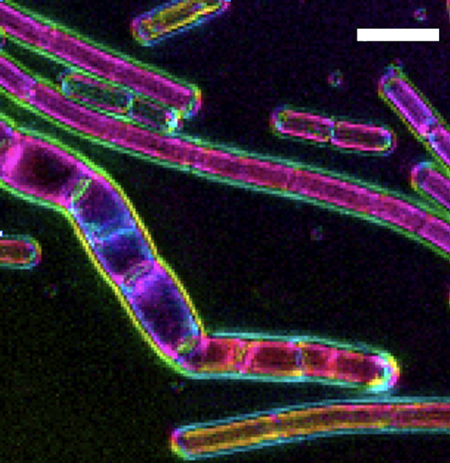Staying in Shape: MBL Microscopy Helps Reveal how Bacteria Grow Long, Not Wide

The slender, rod-shaped Bacillus subtilis is one of the best-studied bacteria in the world, a go-to system for exploring and understanding how bacteria grow, replicate, and divide. One of its outstanding mysteries has been how it manages to keep its precise diameter while growing and getting bigger end-to-end.
This week, a team led by Ethan Garner of Harvard University describes the opposing and balanced enzymatic actions that keep B. subtilis from bulging wide while it builds up its inner cell wall and elongates. The study, in Nature Microbiology, is a collaboration with microscopy developer Rudolf Oldenbourg of the Marine Biological Laboratory (MBL).
Garner and Oldenbourg met in the MBL Physiology course, where Oldenbourg teaches polarization microscopy and Garner was a teaching assistant and later faculty member. “I had been impressed by Rudolf’s work for many years and always hoped that I (or someone) would introduce polarization microscopy to bacterial cell biology,” Garner says. This paper was his opportunity.
 LC-PolScope image of cell wall sacculi purified from Bacillus subtilis with different levels of induction of mreBCD, the genes that build rod shape. Color indicates the molecular orientation, brightness corresponding to degree of alignment in that direction. Credit: Dion, MF. et al (2019) Nature Microbiology, DOI: 10.1038/s41564-019-0439-0
LC-PolScope image of cell wall sacculi purified from Bacillus subtilis with different levels of induction of mreBCD, the genes that build rod shape. Color indicates the molecular orientation, brightness corresponding to degree of alignment in that direction. Credit: Dion, MF. et al (2019) Nature Microbiology, DOI: 10.1038/s41564-019-0439-0With polarization microscopy, scientists can visualize the orientation of individual molecules in a live cell, and how that orientation may change over time. “Polarization microscopy was key to this project,” Garner says, giving his team essential and hard-to-obtain information on the orientation of material that B. subtilis adds to its cell wall as it grows.
“As I have been giving talks on this work, the bacterial community has been incredibly impressed by this [polarization microscopy] assay,” Garner says. “There are many other bacteria that people want to explore with it.”
Oldenbourg, a senior scientist at MBL, is happy to oblige. “We are standing ready to support the bacteria research community through the OpenPolScope Resource at MBL,” he says.
Citation:
Dion, Michael F. et al. (2019) Bacillus subtilis cell diameter is determined by the opposing actions of two distinct cell wall synthetic systems. Nature Microbiology, DOI: 10.1038/s41564-019-0439-0.
—###—
The Marine Biological Laboratory (MBL) is dedicated to scientific discovery – exploring fundamental biology, understanding marine biodiversity and the environment, and informing the human condition through research and education. Founded in Woods Hole, Massachusetts in 1888, the MBL is a private, nonprofit institution and an affiliate of the University of Chicago.